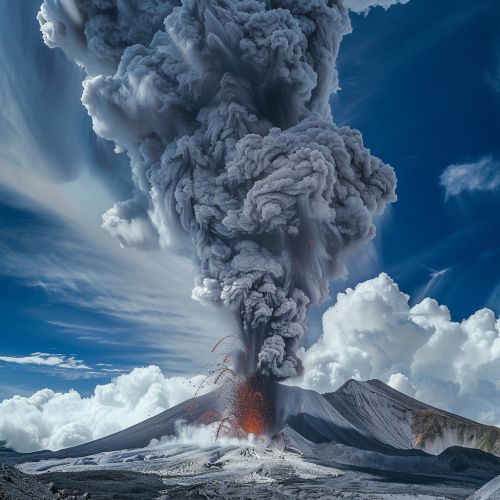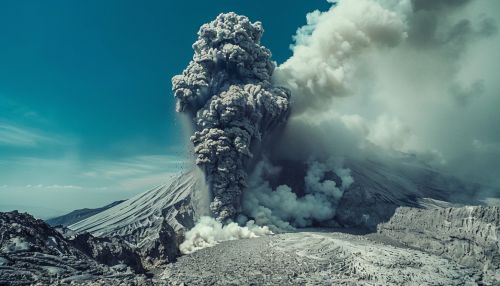Plinian Eruption: Difference between revisions
(Created page with "== Introduction == A Plinian eruption is a type of volcanic eruption characterized by its explosive nature, producing high columns of gas and volcanic ash that can reach the stratosphere. Named after the Roman historian Pliny the Younger, who provided a detailed account of the eruption of Mount Vesuvius in 79 AD, Plinian eruptions are among the most powerful and destructive volcanic events. These eruptions can have significant impacts on the environment, climate, and hum...") |
No edit summary |
||
| Line 20: | Line 20: | ||
The magma involved in Plinian eruptions is typically high in silica content, making it more viscous and prone to explosive fragmentation. This type of magma is often classified as rhyolitic or dacitic. The high viscosity of the magma contributes to the buildup of pressure within the volcanic conduit, leading to a violent release of energy during the eruption. | The magma involved in Plinian eruptions is typically high in silica content, making it more viscous and prone to explosive fragmentation. This type of magma is often classified as rhyolitic or dacitic. The high viscosity of the magma contributes to the buildup of pressure within the volcanic conduit, leading to a violent release of energy during the eruption. | ||
[[Image:Detail-93243.jpg|thumb|center|An erupting volcano with a towering column of ash and gas reaching into the sky, with pyroclastic flows descending the slopes.|class=only_on_mobile]] | |||
[[Image:Detail-93244.jpg|thumb|center|An erupting volcano with a towering column of ash and gas reaching into the sky, with pyroclastic flows descending the slopes.|class=only_on_desktop]] | |||
== Historical Examples == | == Historical Examples == | ||
Latest revision as of 04:57, 22 June 2024
Introduction
A Plinian eruption is a type of volcanic eruption characterized by its explosive nature, producing high columns of gas and volcanic ash that can reach the stratosphere. Named after the Roman historian Pliny the Younger, who provided a detailed account of the eruption of Mount Vesuvius in 79 AD, Plinian eruptions are among the most powerful and destructive volcanic events. These eruptions can have significant impacts on the environment, climate, and human societies.
Characteristics of Plinian Eruptions
Plinian eruptions are marked by several distinctive features:
Eruption Column
The most prominent feature of a Plinian eruption is the towering eruption column, which can reach heights of up to 45 kilometers (28 miles). This column consists of a mixture of volcanic gases, ash, and pumice. The height of the column is influenced by the eruption's intensity, the amount of volcanic material ejected, and atmospheric conditions.
Pyroclastic Flows
Plinian eruptions often generate pyroclastic flows, which are fast-moving currents of hot gas, ash, and volcanic rock that flow down the slopes of a volcano. These flows can reach speeds of up to 700 kilometers per hour (430 miles per hour) and temperatures of about 1,000 degrees Celsius (1,832 degrees Fahrenheit). Pyroclastic flows are highly destructive and can devastate areas within a radius of several kilometers from the volcano.
Tephra Fallout
Tephra, or volcanic ash, is ejected into the atmosphere during a Plinian eruption and can be carried over long distances by wind. The fallout of tephra can blanket large areas, causing damage to infrastructure, agriculture, and respiratory health. The thickness and distribution of tephra deposits depend on the eruption's magnitude and wind patterns.
Volcanic Gases
Plinian eruptions release significant amounts of volcanic gases, including water vapor, carbon dioxide, sulfur dioxide, hydrogen chloride, and hydrogen fluoride. These gases can have various environmental impacts, such as acid rain, air pollution, and climate change. Sulfur dioxide, in particular, can form sulfate aerosols in the stratosphere, leading to global cooling by reflecting sunlight.
Magma Composition
The magma involved in Plinian eruptions is typically high in silica content, making it more viscous and prone to explosive fragmentation. This type of magma is often classified as rhyolitic or dacitic. The high viscosity of the magma contributes to the buildup of pressure within the volcanic conduit, leading to a violent release of energy during the eruption.


Historical Examples
Several notable Plinian eruptions have been documented throughout history, providing valuable insights into their characteristics and impacts.
Mount Vesuvius, 79 AD
The eruption of Mount Vesuvius in 79 AD is one of the most famous Plinian eruptions, primarily due to the detailed accounts provided by Pliny the Younger. The eruption destroyed the Roman cities of Pompeii and Herculaneum, burying them under meters of ash and pumice. The eruption column is estimated to have reached a height of 33 kilometers (20 miles), and pyroclastic flows caused extensive damage and loss of life.
Mount St. Helens, 1980
The eruption of Mount St. Helens in Washington, USA, on May 18, 1980, is another well-known Plinian eruption. The eruption produced a massive lateral blast, a towering eruption column, and extensive pyroclastic flows. The eruption column reached a height of 24 kilometers (15 miles), and the event resulted in significant environmental and economic impacts.
Mount Pinatubo, 1991
The eruption of Mount Pinatubo in the Philippines in June 1991 is considered one of the largest Plinian eruptions of the 20th century. The eruption column reached a height of 35 kilometers (22 miles), and the release of sulfur dioxide led to a global temperature decrease of about 0.5 degrees Celsius (0.9 degrees Fahrenheit) over the following year. The eruption caused widespread destruction and displacement of local communities.
Impacts of Plinian Eruptions
Plinian eruptions can have far-reaching and long-lasting impacts on the environment, climate, and human societies.
Environmental Impacts
The deposition of tephra can alter landscapes, destroy vegetation, and contaminate water sources. Pyroclastic flows can bury entire ecosystems, leading to loss of biodiversity. Volcanic gases can cause acid rain, which can harm aquatic and terrestrial ecosystems.
Climate Impacts
The injection of volcanic gases, particularly sulfur dioxide, into the stratosphere can lead to the formation of sulfate aerosols. These aerosols reflect sunlight, causing a temporary cooling effect on the Earth's climate. The cooling effect can last for several years, depending on the magnitude of the eruption and the amount of sulfur dioxide released.
Societal Impacts
Plinian eruptions can have devastating effects on human societies. The destruction of infrastructure, loss of life, and displacement of populations are common consequences. The economic costs of recovery and rebuilding can be substantial. Additionally, the disruption of air travel due to volcanic ash clouds can have significant economic and logistical implications.
Monitoring and Prediction
Advances in volcanic monitoring and prediction have improved our ability to anticipate and mitigate the impacts of Plinian eruptions.
Seismic Monitoring
Seismic monitoring involves the use of seismometers to detect and analyze volcanic earthquakes. Increased seismic activity often precedes an eruption, providing valuable warning signals. The analysis of seismic data can help determine the location, depth, and magnitude of volcanic activity.
Gas Emissions Monitoring
Monitoring volcanic gas emissions, particularly sulfur dioxide, can provide insights into the state of a volcano. Increased gas emissions can indicate rising magma and increased volcanic activity. Remote sensing techniques, such as satellite-based measurements, are commonly used to monitor gas emissions.
Ground Deformation Monitoring
Ground deformation monitoring involves the use of techniques such as GPS and InSAR (Interferometric Synthetic Aperture Radar) to detect changes in the shape of a volcano. Inflation or deflation of the volcanic edifice can indicate the movement of magma beneath the surface.
Thermal Monitoring
Thermal monitoring involves the use of infrared cameras and satellite-based thermal sensors to detect changes in surface temperature. Increased thermal activity can indicate rising magma and increased volcanic activity.
Conclusion
Plinian eruptions are among the most powerful and destructive volcanic events, characterized by towering eruption columns, pyroclastic flows, and widespread tephra fallout. These eruptions have significant environmental, climatic, and societal impacts. Advances in volcanic monitoring and prediction have improved our ability to anticipate and mitigate the impacts of these eruptions, but the challenges of living in the shadow of active volcanoes remain.
